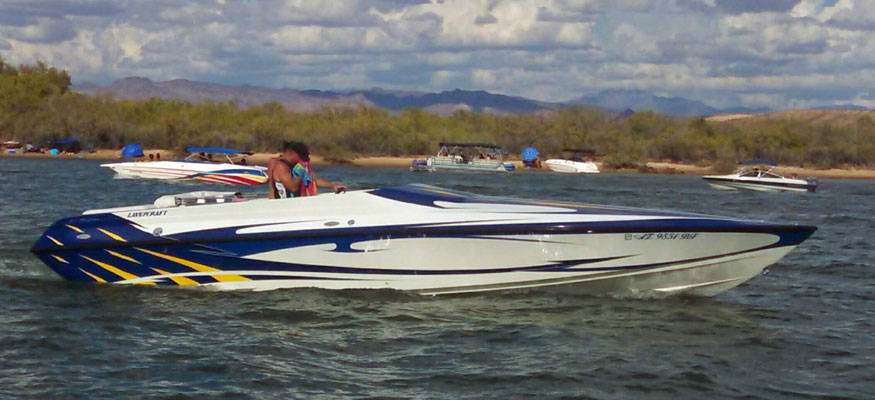Advertisement
Advertisement
Two New Go-Fast V-Bottoms Under 30 Feet
Inboard or outboard, single-engine V-bottom options are slowly improving for performance-minded buyers on a budget.
July 7, 2016
Talk to the folks who own today’s hottest high-performance powerboats in the 40- to 50-foot range and you’ll learn pretty quickly that most didn’t start with those rides, that many of which—on the catamaran side—can top 160 MPH. In fact, most began their go-fast boating lives with single-engine V-bottoms that barely reached 60 MPH, and then progressed through a series of faster and larger models before they bought their current boats.

With outboard power, Tuff Marine’s latest 28-footer should top 100 MPH.
But with the recession of 2008 and the near extinction of production-built go-fast boats, the closed-deck single-engine V-bottom has almost, with a few exceptions such as Active Thunder’s 29 Savage, gone the way of the dinosaur (and while Active Thunder’s 29-footer can be a equipped with a big-block engine, the first and only model built to date was ordered with outboards).
Among the other exceptions is the Tuff Marine 28, a sleek hot-rod of a sportboat built in Cambridge, Ontario, Canada. A while back, company principal Mark Weigl built one with a 725 HP engine from Ilmor Marine, and the boat reportedly topped 120 MPH. But with outboard engines, the hottest power move you can make in the sport catamaran and performance center-console world these days, Weigl built a 28-footer with twin Mercury Racing Verado 400R outboard engines on Porta Marine transom brackets this year. And while the final test numbers aren’t in, he said he eventually expects the boat to run between 105 and 115 MPH.
Tuff Marine boats are built with a lamination process called resin-infusion, which enables the builder to precisely control how much resin is used in conjunction with standard fiberglass. For added strength, balsa coring is used in the hull bottom and foam is employed in the 28-footer’s hull sides and deck. Weigl said he puts a 60-gallon fuel tank in the boat because most people use it for day-boating and it’s so fuel efficient, he doesn’t see the point of adding more weight. The Tuff 28 interior layout is simple but functional, with two buckets up front and a bench across the stern. Instruments and controls are from Livorsi Marine.
For a relatively small sum of money—and in the go-fast powerboat market “relatively small sum” are important words to use anytime you talk about prices—you could order a Tuff 28 with Verado 400R outboards right now.
But for a new version of the once-popular Lavey Craft 29 NuEra with a big-block engine and stern drive, you’ll have to wait another year. That project is a collaboration between John Mosetti, a Texas-based powerboat industry veteran who originally hails from the East Coast, his brother Richard, and Lavey Craft Motorsports principals Chris Camire and Dave Sampson.

A new version of the LaveyCraft 29 NuEra will be on the water—and likely coming to a poker run near you—in 2017.
If you haven’t heard the Lavey Craft name in a while, you’re not alone—the company all but disappeared during the recession and the challenging years that followed. But while Camire and Sampson have branched off into making aftermarket fiberglass parts for wildly popular off-road vehicles for companies such as Polaris, they kept all the original Lavey Craft powerboat tooling.
In late 2015, Mosetti approached them to build a 29 NuEra hull that he would rig with a 540-cubic-inch, 650-plus-HP fuel-injected and naturally aspirated engine. Camire and Sampson agreed to take on the project. Their goal, like that of Mosetti, is not just to help revive the Lavey Craft brand. They want to help spark a revival in the closed-deck sportboat market.
To that end, the Mosetti brothers plan to take the completed 29-footer “on tour” to major go-fast powerboating events such as Michigan’s Boyne Thunder Poker, New York’s Buffalo Poker Run, and the Pirates of Lanier Poker Run in Georgia in 2017. They’ll spend the rest of this year finishing the boat and getting it ready for next season on the water.
“You have to get out there and draw interest,” said John Mosetti. "I would love to bring a single-engine V-hull back into the market. It won’t have an open bow or a mid-cabin. It will be a cuddy-cabin boat.”
“We're trying to inject some life back into the brand,” said Sampson. “We built a boat last summer, a 24-footer with some new features including a fiberglass pan and a few new twists. We’ve been talking with John [Mosetti] for quite some time, and he has a lot of marine industry experience."
“A 29-foot V-bottom is about the biggest boat you can push with a single engine and still have good performance—and one that most guys can still afford,” he continued. “Our 29 is big enough to handle big water to a certain degree, but small enough to be affordable. There aren’t many people making them any more.”
Even with Tuff Marine and Lavey Craft (tentatively and carefully) getting back into the single-engine sportboat game, there still won’t be “many people” making such boats. Yet both models appear to be a positive step to fill a void in the marketplace. The seismic downward shifts in the high-performance powerboat world means there simply isn’t enough demand for mass-produced sportboats less than 30 feet long (and just about everything bigger these days is custom-built). But there’s still enough hunger out there for a handful of well-crafted—and well-priced—offerings in that segment. So the current Tuff Marine and future Lavey Craft offerings are good news.
Advertisement
Related Boats for Sale
See more boats like thisAdvertisement

















